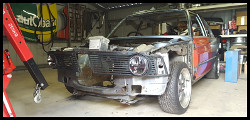So I just discovered air cups, and they seem like a great Idea for someone on a budget (aka, everyone riding static lol), however most kits require you to buy a full coilover with a shorter spring and cup installed. (which is stupid, if you wanna raise and lower you're just gonna get air struts for the same or less cost) I already have coilovers, a shorter spring, and I can take my perches out, so really I just need the cups. Does anyone know anybody who sells cups only that arent 1,600 like the Mullers?
Announcement
Collapse
No announcement yet.
Air Cups that cost less than bags.
Collapse
X
-
Tags: None
-
-
Anyone have any info/experience on the stance solutions static+? $650 is a way better deal than flushstance/umbrella/phantomhttp://Coletrane.co
Beats. Drums. Soundtracks.
Comment
-
Im concerned about it damaging my shocks. The shocks are valved for springs are 10k and 12k and I imagine the bags would have to have a lot of pressure in them to maintain a rate somewhere around there. Megan Racing advised against it, but is it really that bad?http://Coletrane.co
Beats. Drums. Soundtracks.
Comment
-
The only damage that could come to your shocks is from over-extension or over-compression. Over-extension is rarely an issue in our use case, but over-compression is. The dangers of over-compression can easily be alleviated with the use of rubber bumpstops on your shock rod.
Air springs are also highly progressive, and ramp up spring rate geometrically with compression, whereas single-rate springs maintain the same spring rate throughout their cycle, which means that by the time your shock is compressed enough that the piston is going to start running into things, it's possible your air springs will have as high or higher an instantaneous spring rate than your current springs. It ultimately boils down to component choice and installation, however.
Comment
-
So slap some Eibach bumpstops on the top of the shocks and it should minimize issues? Megan said stay within +-2k of the spring rate, but I feel like it wouldn't be huge if you had an air spring that was at a higher instantaneous spring rate because it would move the shock less correct?http://Coletrane.co
Beats. Drums. Soundtracks.
Comment
-
You do not want an air spring with a higher instantaneous spring rate than your shock manufacturer recommends anywhere within typical travel, as your shock will not have an appropriate damping factor to control the air spring.
Lower than recommended is fine in terms of the shock's ability to damp the spring, but then you get into issues of not having enough spring rate to keep the suspension from crashing on heavy bumps. A bumpstop will help in this regard, but if your suspension system is designed around a bumpstop as an integral component in typical travel, it is incorrectly designed.
Ideally, we would not be designing around a pre-existing shock absorber, but rather selecting a shock absorber based on damping characteristics appropriate to the air spring and its installation. Barring that, you want to design for an air spring that is within the shock absorber's spring rate specifications for the entire range of compressive travel it will see on a usual basis.Last edited by Oh Damn, it's Sam; 12-23-2014, 02:48 PM.
Comment
-
So if I inderstand correctly my coilovers are a good case for air since they're valved for higher rates and I can keep them under the threshold of the original spring rate. I'd like to stay on the Megan coils since they're the only cool for the EP3/RSX that mount the tie rod on the bottom, which corrects the geometry a lothttp://Coletrane.co
Beats. Drums. Soundtracks.
Comment
-
High damping factor is a positive attribute for shocks used in air ride applications, yes. And if these are all there is out there, well, working around them should be doable.
You can get a reasonable approximation of what your instantaneous spring rate will be for air springs at various points of the suspension's travel if you know a few details about your setup with this equation:

where:
w is the weight of the corner you are interested in.
h1 is the internal height of the airbag at ride height. This depends on installation and is where you can make adjustments to fine-tune the performance of your system.
h2 is the minimum internal height of the air bag. For most air bags this will be zero, though some bags that have internal bumpstops as well as some sleeve-style bags can be different.
x is the amount of deflection from ride height you're interested in at the bag itself with extension in the positive direction and compression in the negative direction. For instantaneous rate at ride height, this is zero, though you can plug in other numbers to see how the rate will ramp up and down as the suspension cycles.
If you plug in weights in lbs and heights and deflection in inches, you will get the spring rate in lb/in. If you plug in kg and mm, you will get kg/mm or K.
To illustrate, we can use my car. My front corners weigh 450 kg, my SS-5s have an internal height of 50mm at ride height, an internal height of 0mm fully compressed, and we'll check the rate at ride height, so deflection will be zero:
450 kg / (50mm - 0mm + 0mm) = 9 kg/mm
If I wanted to see what happened when I compressed the bag by 10mm, I'd set x to -10mm and recompute:
450 kg / (50mm - 0mm + -10mm) = 11.25 kg/mm
You can continue this for all reasonable values of X and build yourself a graph of how the spring rate of each bag will change as the suspension cycles. Again, this is a loose approximation, but I found it very useful when designing my own system.Last edited by Oh Damn, it's Sam; 12-25-2014, 08:52 PM.
Comment
-
I'm gonna go through and build a graph with that equation once I get on my laptop and can look up my weight ratio and stuff. Messing with the equation on my phone made me realize that this should be workable because of how the coilovers adjust height without travel being affected. So say my ride height is with the bag extended 6in and that's too high of a spring rate, raise the static height and run the bag at 5in for ride height instead (Or whatever height I need to get my desired instantaneous spring rate) what do you mean by the internal height of the bag? Like Aero Sports are 4in compressed, so say the bag is at 6in (h1), you subtract 4in(h2)and get 2in right?http://Coletrane.co
Beats. Drums. Soundtracks.
Comment
-
Yep, you can do a lot of adjustment to tweak spring rates with a coilover setup, just so long as you leave enough uptravel that the bag doesn't bottom out over bumps.
Following the equation, the more compressed the bag is at ride height, the higher the spring rate.
For internal height, imagine the bag as just a simple 100mm high hollow canister with end caps 10mm thick, with no bumpstops or anything interesting inside. Internal height would be the height of the bag minus the end caps, so 80mm. On a simple bag, subtracting the compressed height like you suggest will produce the same result. Things get a little more complicated if you've got a bag with an internal bumpstop that doesn't cover the entire cap area like some Air Lift bags have.
Comment
-
Heres the crude graph I drew up from the data for the car's ride height with no deflection:
Civic EP3: (Weight distro is for Type R since I couldn't find it for the Si)
X- axis is the bag height in Inches
Y- axis is the spring rate in kilograms/mm

So as ride height must be 5 in or above at minimum, ideally higher to compensate for deflection. Whats a good number to calculate deflection for average road bumps? I used 1 inch, but havent made a graph for that yethttp://Coletrane.co
Beats. Drums. Soundtracks.
Comment
-
You have made a couple of small errors with your calculations, though one of them you couldn't have known about.
First, since you used inches as your measurement, your results are in kg/in not kg/mm.
Second, if you look at a cutaway of an Aero Sport bag (like so), you'll see that the bag's internal height does not fall to zero when the bag is fully-compressed. The collar around the shock absorber tube runs out of travel before the two caps run into each other. Thus, h2 in the equation is non-negligable. I don't have blueprints of an Aero Sport bag in my hands, but just guessing based on the photo, I'd plug in 40mm or so for h2.
Using the above, and adding in the weight data I could find in 5 seconds of Google searching (1321 kg, 61/39 weight balance), I get the following chart:

To calculate possible deflection for road bumps, you really need some engineering chops, which is beyond my skillset, and it ultimately depends on how shit your roads are and how shit a driver you are. The way I handled it was to look at the ride height I was shooting for and measure how much travel I had until things started running into other things. I padded that by an inch or so just to make sure the bag wasn't going to be the limiting factor, and went with that. So far, it's worked.
Comment
-
I'll have to tweak it with the new h2 value. Also the inches is just for reference, I did convert all inch values to mm before dividing. What program do you use for graphing?http://Coletrane.co
Beats. Drums. Soundtracks.
Comment







Comment